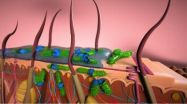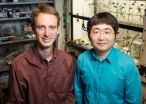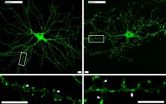(Press-News.org) Like a protective tent over a colony of harmful bacteria, biofilms make the treatment of skin infections especially difficult. Microorganisms protected in a biofilm pose a significant health risk due to their antibiotic resistance and recalcitrance to treatment, and biofilm-protected bacteria account for some 80 percent of total bacterial infections in humans and are 50 to 1,000 times more resistant to antibiotics than simpler bacterial infections.
"In essence, we may have stumbled onto a magic bullet," said David Fox, a Los Alamos National Laboratory researcher on the project. "Through a robust screening strategy, our research team has identified a unique class of materials, known as ionic liquids, which both neutralize biofilm-forming pathogens and deliver drugs through the skin," he said.
"We extended our current capability in antimicrobial platforms with ionic liquids to new heights by partnering with Dr. Mitragotri at UCSB, who is an expert in transdermal drug delivery platforms. The merger made perfect sense," stated Fox.
"In several cases, we found the ionic liquid was more efficacious on a biofilm than a standard bleach treatment and exhibited minimal cytotoxicity effects on human cell lines (unlike bleach). This has excellent prospects for aiding antibiotic delivery to the pathogen through biofilm disruption but, most interestingly, the ionic liquids themselves are quite effective for pathogen neutralization," Fox said.
This work could have especially useful applications for military medical treatments, he noted, where soldiers in the field can be exposed to bacterial infections that are particularly difficult to treat.
Biofilms often persist in the periphery of an actual wound, beneath an intact, healthy skin layer and the difficulty of their treatment is largely due to the outermost layer of the skin, the stratum corneum, being a natural barrier for drug delivery.
"If the bacterial biofilm can be disrupted, delivery of antibiotics is greatly enhanced, and any dispersed pathogens are generally restored to normal antibiotic susceptibility," said Fox. "Further, many bacterial infestations in wounds penetrate under the outer skin layer, the stratum corneum, and deep into the tissue (epidermis and dermis). These materials are able to penetrate through the skin and effectively carry antibiotics to the deepest layers."
"Clearly, the ionic liquids would be of special benefit to our warfighters where exposure to biological agents in hostile environments is likely. Topical application as a prophylaxis or direct treatment to an open wound could buy enough time to reach the proper medical facilities when in an austere environment," he said. Importantly, ionic liquids can be derived from very cheap starting materials that are FDA approved and are extremely stable to high temperatures and pressures, which are necessary traits for commercialization in real-world applications.
In a groundbreaking manuscript appearing this week in the Proceedings of the National Academy of Science, as part of a multi-institutional effort between Los Alamos, University of California Santa Barbara, Dixie State University and Northern Arizona University, researchers explored exploiting ionic liquids both in a concerted effort to combat antibiotic-resistant bacterial biofilms in skin, as well as for topical transdermal drug delivery. The comprehensive strategy resulted in the identification of ionic liquids that are effective at disrupting biofilms, neutralizing pathogens, and enhancing delivery of antibiotic into skin.
Biofilms are a major cause of chronic wounds and wound degeneration. Wounds from infected surgical incisions result in 1 million additional hospital days. Additional causes of bacterial infected wounds include traumatic injuries, as well as diabetic foot ulcers, venous leg ulcers, and pressure ulcers.
The total economic burden of skin disease was estimated to be approximately $96 billion in 2004, and the prevalence and healthcare costs for skin disease have been increasing over the last three decades. Bacterial infections in the skin are among the most common diagnoses in hospital patients, accounting for some 10% of all hospital visits. Staphylococcus aureus infections acquired in hospitals, which account for only 16% of nosocomial infections, are estimated to result in $9.5 billion in extra patient costs and 12,000 deaths annually.
The comprehensive approach is unique in that the team examined a panel of in-house synthesized ionic liquids and enabled the discovery of one ionic liquid, choline-geranate, which showed excellent antimicrobial activity, minimal toxicity to epithelial cells as well as skin, and effective permeation enhancement for drug delivery. Specifically, choline-geranate was comparable with, or more effective than, bleach treatment against established biofilms of Salmonella enterica and Pseudomonas aeruginosa, respectively. In addition, choline-geranate increased delivery of cefadroxil, an antibiotic, by >16-fold into the deep tissue layers of the skin without inducing skin irritation.
INFORMATION:
The paper: Ionic liquids as a class of materials for transdermal delivery and pathogen neutralization
Authors: Michael Zakrewsky, Vivian Le, Samir Mitragotri (University of California, Santa Barbara), Katherine S. Lovejoy, Theresa L. Kern, Tarryn E. Miller, Amber Nagy, Andrew M. Goumas, Rashi S. Iyer, David T. Fox (Los Alamos National Laboratory), Rico E. Del Sesto (Dixie State University, St. George, UT), and Andrew T. Koppisch (Northern Arizona University, Flagstaff, AZ).
Funding: This research was funded by University of California, Office of the President Grant 12-LR-237080. FTIR was performed in the Materials Research Laboratory (MRL) Shared Experimental Facilities, supported by the Materials Research Science and Engineering Centers Program of the National Science Foundation (NSF) under Award DMR 1121053. A patent application has been filed on the syntheses and biological applications of the ionic liquids. END
Breakthrough antibacterial approach could resolve serious skin infections
Los Alamos and partners test ionic liquids to break bacterial biofilm layer and save lives
2014-08-26
ELSE PRESS RELEASES FROM THIS DATE:
Scientists craft atomically seamless, thinnest-possible semiconductor junctions
2014-08-26
Scientists have developed what they believe is the thinnest-possible semiconductor, a new class of nanoscale materials made in sheets only three atoms thick.
The University of Washington researchers have demonstrated that two of these single-layer semiconductor materials can be connected in an atomically seamless fashion known as a heterojunction. This result could be the basis for next-generation flexible and transparent computing, better light-emitting diodes, or LEDs, and solar technologies.
"Heterojunctions are fundamental elements of electronic and photonic devices," ...
Personal protective equipment is critical but not enough to shield health care workers from Ebola
2014-08-26
Personal protective equipment is critical but not enough to shield health care workers from Ebola*
Free content
Personal protective equipment designed to shield health care workers from contaminated body fluids of Ebola patients is not enough to prevent transmission, according to a commentary being published early online today in Annals of Internal Medicine. Despite the known effectiveness of barrier protection in blocking Ebola transmission, infections among health care workers have played a major role in outbreaks. William A. Fischer II, MD from the University of North ...
Challenges ahead in improving child health by increasing access to sanitation in India
2014-08-26
A study published in this week's PLOS Medicine on large-scale rural sanitation programs in India highlights challenges in achieving sufficient access to latrines and reduction in open defecation to yield significant health benefits for young children.
The researchers, led by Sumeet Patil from the School of Public Health, University of California at Berkeley, and the Network for Engineering and Economics Research and Management in Mumbai, India conducted a cluster randomised controlled trial in 80 rural villages in the Indian state of Madhya Pradesh to measure the effect ...
A glucose meter of a different color provides continuous monitoring
2014-08-26
CHAMPAIGN, Ill. — University of Illinois engineers are bringing a touch of color to glucose monitoring.
The researchers developed a new continuous glucose monitoring material that changes color as glucose levels fluctuate, and the wavelength shift is so precise that doctors and patients may be able to use it for automatic insulin dosing - something not possible using current point measurements like test strips.
"There are significant limitations to current continuous glucose monitoring technologies," said study leader Paul Braun, a professor of materials science and ...
NASA's TRMM and Aqua satellites gaze into Hurricane Cristobal
2014-08-26
NASA's TRMM and Aqua satellites have been providing views of the outside and inside of Hurricane Cristobal as it heads for Bermuda. The National Hurricane Center posted a Tropical Storm Watch for Bermuda as Cristobal heads in that direction.
Strong winds and flooding associated with Tropical Storm Cristobal caused deaths in the Dominican Republic, Haiti, and Jamaica. The Tropical Rainfall Measuring Mission or TRMM satellite captured rainfall data from Cristobal on August 24, 2014 at 1150Z (7:50 a.m. EDT). Light to moderate rainfall was occurring throughout much of the ...
Satellite shows Hurricane Marie about to swallow Karina
2014-08-26
Massive Hurricane Marie appears like a giant fish about to swallow tiny Tropical Depression Karina on satellite imagery today from NOAA's GOES-West satellite. Karina, now a tropical depression is being swept into Marie's circulation where it is expected to be eaten, or absorbed.
An image from NOAA's GOES-West satellite on Aug. 26 at 8 a.m. EDT shows Karina being drawn into the powerful and large circulation of Hurricane Marie to the east of the depression. The image was created by NASA/NOAA's GOES Project at NASA's Goddard Space Flight Center in Greenbelt, Maryland.
Forecasters ...
NASA sees huge Hurricane Marie slam Socorro Island
2014-08-26
NASA's Terra satellite passed over Hurricane Marie when its eye was just to the west of Socorro Island in the Eastern Pacific. Marie's eye may have been near the island, but the storm extended several hundreds of miles from there.
On Aug. 25 at 18:20 UTC (2:20 p.m. EDT) the Moderate Resolution Imaging Spectroradiometer or MODIS instrument aboard NASA's Terra satellite captured Hurricane Marie's center just west of Socorro Island. The image showed Marie's tightly wound center and eye. A thick band of powerful thunderstorms surrounded the center of circulation, and bands ...
Lack of naturally occuring protein linked to dementia
2014-08-26
Scientists at the University of Warwick have provided the first evidence that the lack of a naturally occurring protein is linked to early signs of dementia.
Published in Nature Communications, the research found that the absence of the protein MK2/3 promotes structural and physiological changes to cells in the nervous system. These changes were shown to have a significant correlation with early signs of dementia, including restricted learning and memory formation capabilities.
An absence of MK2/3, in spite of the brain cells (neurons) having significant structural ...
Existing power plants will spew 300 billion more tons of carbon dioxide during use
2014-08-26
Irvine, Calif. — Existing power plants around the world will pump out more than 300 billion tons of carbon dioxide over their expected lifetimes, significantly adding to atmospheric levels of the climate-warming gas, according to UC Irvine and Princeton University scientists.
Their findings, which appear Aug. 26 in the journal Environmental Research Letters, are the first to quantify how quickly these "committed" emissions are growing – by about 4 percent per year – as more fossil fuel-burning power plants are built.
Assuming these stations will operate for 40 years, ...
Brain benefits from weight loss following bariatric surgery
2014-08-26
Washington, DC—Weight loss surgery can curb alterations in brain activity associated with obesity and improve cognitive function involved in planning, strategizing and organizing, according to a new study published in the Endocrine Society's Journal of Clinical Endocrinology & Metabolism (JCEM).
Obesity can tax the brain as well as other organs. Obese individuals face a 35 percent higher risk of developing Alzheimer's disease compared to normal weight people.
Bariatric surgery is used to help people who are dangerously obese lose weight. Bariatric surgery procedures ...
LAST 30 PRESS RELEASES:
Why can zebrafish regenerate damaged heart tissue, while other fish species cannot?
Keck School of Medicine of USC orthopaedic surgery chair elected as 2024 AAAS fellow
Returning rare earth element production to the United States
University of Houston Professor Kaushik Rajashekara elected International Fellow of the Engineering Academy of Japan
Solving antibiotic and pesticide resistance with infectious worms
Three ORNL scientists elected AAAS Fellows
Rice bioengineers win $1.4 million ARPA-H grant for osteoarthritis research
COVID-19 booster immunity lasts much longer than primary series alone, York University-led study shows
Bentham Science joins United2Act
When thoughts flow in one direction
Scientists identify airway cells that sense aspirated water and acid reflux
China’s major cities show considerable subsidence from human activities
Drugs of abuse alter neuronal signaling to reprioritize use over innate needs
Mess is best: disordered structure of battery-like devices improves performance
Skyrmions move at record speeds: a step towards the computing of the future
A third of China’s urban population at risk of city sinking, new satellite data shows
International experts issue renewed call for Global Plastics Treaty to be grounded in robust science
Novel material supercharges innovation in electrostatic energy storage
A common pathway in the brain that enables addictive drugs to hijack natural reward processing has been identified by Mount Sinai
China’s sinking cities indicate global-scale problem, Virginia Tech researcher says
Study finds potential new treatment path for lasting Lyme disease symptoms
Metabolic health before vaccination determines effectiveness of anti-flu response
Department of Energy announces $16 million for traineeships in accelerator science & engineering
MRE 2024 Publication of Enduring Significance Awards
UCalgary researchers quantify the connection between homelessness and mental health disorders
Fourteen years after the Gulf of Mexico oil spill, endemic fishes face an uncertain future
For more open and equitable public discussions on social media, try “meronymity”
Marine microbial populations: Potential sensors of the global change in the ocean
Metacognitive abilities like reading the emotions and attitudes of others may be more influenced by environment than genetics
Salk Professor Satchin Panda named 2023 AAAS fellow
[Press-News.org] Breakthrough antibacterial approach could resolve serious skin infectionsLos Alamos and partners test ionic liquids to break bacterial biofilm layer and save lives







